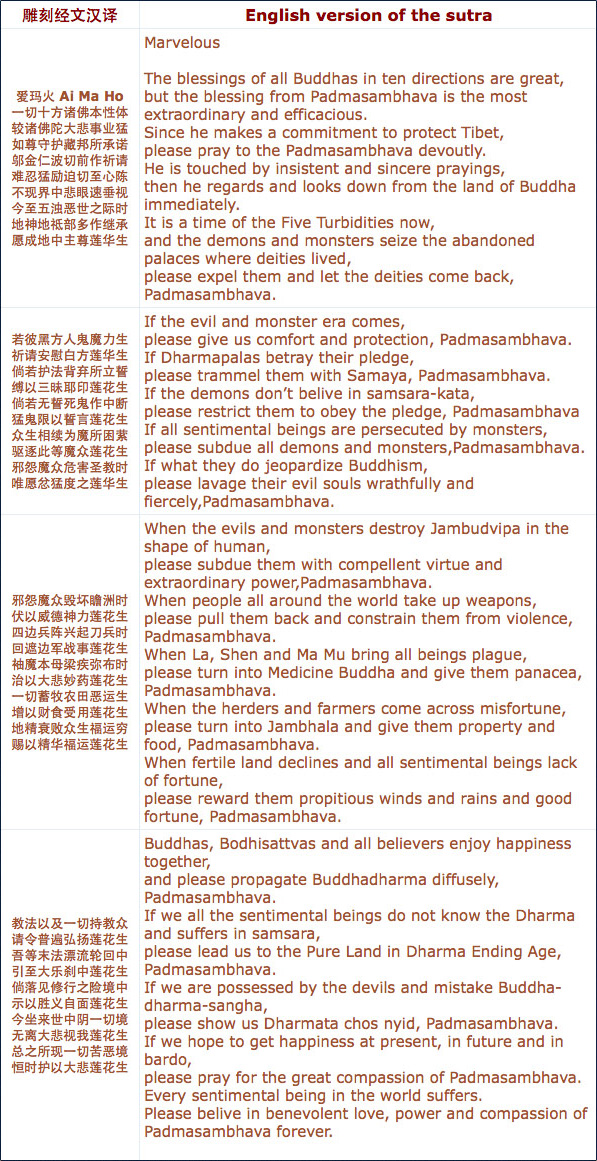Prayer of Padmasambhava for Saving All Sufferings
中文 ENGLISH
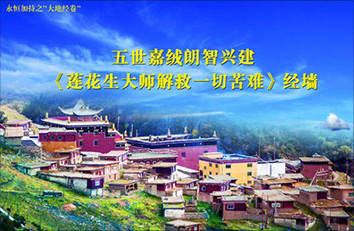
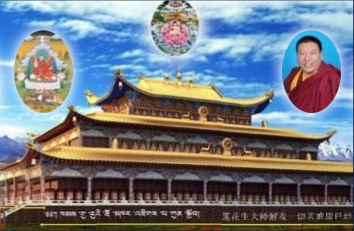
The 5th GryaRong Namgr Rinpoche says, a person is destined to accumulate the immeasurable blessings even if he just engraves only one piece of Mani stones. Because a place with the sutra of prayer of Padmasambhava for saving all sufferings, is like Padmasambhava's palace, where Padmasambhava devotes himself to the happiness and supplications of all sentient beings.
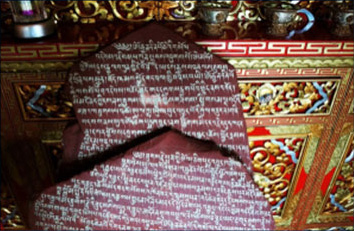
Every participant of Mani stone engraving, no matter which one of the six realms of samsara he will reborn, will be continuously receiving blessings from the Mani stones. No matter who, as long as persuade other people, transport the stones, subsidize or provide craftsmen diet, will get good karmas, and ultimately will arrive on the Buddha-land. Moreover all participants not only gain merits of engraving Mani stones, but also receive merits of prayers who walk around them; Manistones won't decay even in thousands of years, and the merits increase everyday. Therefore Mani stones are "scrolls of the earth" in ups and downs of time .

In July 2012, the guru and disciples went to the construction site of the supplication sutra wall of "Prayer of Padmasambhava for Saving All Sufferings", which is near the A Se Temple in Xiazha district, and filled up the treasured bottle and hung prayer flags at the commencement ceremony.
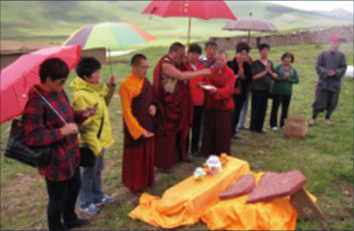
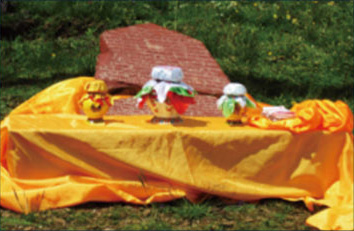
Our guru the 5th GryaRong Rinpoche and the guru Xan Pan Dor Je who is in charge of Kham Mani sutra wall project chanted the scriptures and filled up auspicious bottle, ksitigarbha bottle and wealth bottle together. They wished this project will bring all beings fortunes and auspiciousness.

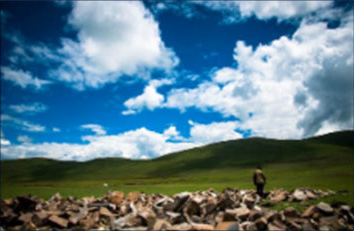
The whole project of the Mani sutra wall in Kham area is related to fortunes and happiness of all generations. The whole project includes not only carving of Man stones, but also the construction of hall, Prayer Wheels, golden Dharma Wheel and mascots. The one, who participates in any part of the project, participates and achieves all merits of the project.
The project is very huge ,which demands large volume of stones, the sutra of the prayer is long, and all Mani stones need manual sculpture. All these facts raise the difficulty of the project a lot. However Our guru says that merits and virtues are tremendous. Anyone is destined to accumulate the immeasurable blessings even if he just engraves only one piece of Mani stones. Because a place with the sutra of prayer of Padmasambhava for saving all sufferings, is like Padmasambhava's palace, where Padmasambhava devotes himself to the happiness and supplications of all sentient beings.
ORIGIN
It is a Karma coincidence by which Dharma friend Tashi in Nanjing chanted "Prayer of Padmasambhava for Saving All Sufferings " and got great blessings when he accidentally downloaded the master's chanting from the Grya Rong Temple web site. Furthermore, he saw the prayer was added to recitation lesson in Ya Qing temple in 2011. So Tashi prayed for the fifth Grya Rong Namgr Rinpoche to engrave the prayer on Mani stones. And Rinpoche also saw that it is the time for believers in Han areas to participate in praying for Padmasambhava . On the Guru Rinpoche's Day 10th, September in Tibetan Canlendar, 2011, Rinpoche started to prepare for the construction of the supplication sutra wall of "Prayer of Padmasambhava for Saving All Sufferings" and prayed for the Padmasambhava's blessings to help all beings out of suffering and get happiness.
The honorable author of Terma: It was the first Chewu Rigzin•Chenbo Rinpoche, whose fifth incarnation was the father of the fifth Grya Rong Namgr Rinpoche who digged out the terma which then was propagated by the praying of the chieftain in Dege, and now it is the right time to propagate it widely. The first Chewu Rigzin•Chenbo Rinpoche was regarded as the second Padmasambhava. So the place, where he retreated in Xiazha district, ShiQu county, was called another Copper-colored Auspicious Mountain.
The greatness of Terma:Since the terma was taken out in modern times, it has significant blessing power in the present era, the Dharma Ending Period. And Padmasambhava's compassion and blessing is actually getting more and more powerful in this period! All sentimental beings, who suffer fearfulness and tribulations a lot in this period, have insufficient fortune to get enough blessings. And Padmasambhavais so merciful that he brings us the special Dharma, Prayer of Padmasambhava for Saving All Sufferings, and it is the right time to propagate and practice it. All these terma that are taken out in recent era, are aimed at helping we all sentimental beings in the Dharma Ending Period. This kind of terma is fateful, the most appropriate, and beneficial most for us. We should cherish them. And we should not ignore the difficulty of getting them!
The specialness of place: Shiqu, which is the producing area of Mani stone materials, has a perfect foundation for the carving of Mani stones. Furthermore, the supplication sutra wall will be built at the fifth Grya Rong Namgr Rinpoche's birthplace which is between the A Se temple and the Nuor Long temple in ShiQu district. Our guru pravrajana and built a Main Assembly Hall in the A Se temple. the Nuor Long temple is the place where Rinpoche's father - the fifth Chewu Rigzin•Chenbo Rinpoche retreated before. Our guru built an exclusive school to show his gratitude to four kinds of favors of Buddha. It is our guru's compassion that the supplication sutra wall is built between the A Se temple and the Nuor Long temple from where we can see the supplication sutra wall. It is a heart to heart inheritance link among us, our guru and the patriarch-the fifth Chewu Rigzin•Chenbo Rinpoche. Although it is the Dharma Ending Period, we are so lucky to participate in constructing the wall on the holy land where our guru was born, pravrajana and practiced Dharma. Like Lord Milarepa said - "The place where your guru lives or goes, is the most sacred site of pilgrimage, and also the most wholesome and auspicious practice place.
The Greatness of Stone carving: There are a lot of merits for participating in carving Mani stones. If you contribute to the engraving of Padmasambhava Mantra on a stone, you will get not only the merit of engraving Mani stones, but also all merits of walking and praying around the Mani stones. Mani stones can be preserved for a very long time, even for thousands of years. Mani merits will not disappear even stones have rotten. Those stones in the wilderness are the "Scroll of the Earth" in ups and downs of tome.
Long-term engraving: There will be many craftsmen involved in the construction of the wall for a long time. The original motivation now is like the wick of a lamp, but to light the lamp requires pouring into oceans of ghee. Hope all Catu Parisa or the people predestinate with Buddha, the eco-industrial or intellectual, regardless of nationality and color contribute to the benefaction, and step on the road of extrication together, and meet on the Pure Land in future!

For years, Patrul Rinpoche engraved scriptures and Dharani on the stones by the money from all the supports and sponsorship, and piled up the engraved stones to make a supplication wall. In this way, he sponsored many poor people and poor artists, encouraged them to complish good karma for others. The supplication wall has been called "Patrul Stone Scripture Heap" since then.
Patrul Rinpoche once said: "As long as the construction of Mani Stones is complished, There is no need to repair the roof to prevent leaks in summer, to sweep the snow to fend off the coldness in winter, to be beware of bird's nests and rat problems, and to have a steward and a lamp lighter. Other people only do some trivial things to get merits like only grab the branches of a tree that can benefit beings . However we do the prime deed to benefit all beings like hold the root of the tree. Even if evils and robbers are all over the mountains and plains, we also need not to concern about the safety of the stones and they will exist in many generations."
The construction program of the supplication wall of "Prayer of Padmasambhava for Saving All Sufferings", with a total construction area of 4320 squared meter, includes projects of engraving of Mani stones, and of building Prayer Wheels, niches for Buddha, the images of Buddha, the wind-bells, mascot statues, quadrangle cornices, dharma-cakras, golden-roofs,etc .
General appearance: The building is a three-layer palatial design with all inner space being placed by Mani Stones. The exterior wall of the building is red. The roof with cornices of each layer is gold-plated. Those make the whole building look noble, simple and elegant. Each quadrangle eave hangs a wind-bell, and leads us to a beautiful artistic conception when it is touched by the gentle breeze. Eight-Blessing golden dharma-cakras with two deers aside on the first and the second roof represent Budhhism and the first taught of the Dharma in Sarnath by Buddha. Gold-plated stereo auspicious unicorn stands in the front of the roof of temples, and it emits brilliant rays which symbolizes peace and compassion of Dharma. The banner-of-victory, which symbolizes the victory of Great Perfection, at the top of the third layer, has the merit of defeating four monsters.
Building height: 27 meters. Pedestal: 2.6 meters high
The first layer: 6 meters high; The second layer: 5.8 meters high, The third layer with roof: 12.6 meters high.The pedestal and the first layer is filled with Mani stones. 140 big Prayer Wheels (2.25 m x 1.3 m) will be set up in the peripheral gallery of the first layer. The billions of copies of mantras of Buddha's three incarnations, Amitabha, Avalokitesvara and Padmasambhava, will be placed in each of the prayer wheel. Hundreds of thousands Mani stones are placed inside the second and the third layer. Moreover niches with thangkas of Padmasambhava's stories and 224 images of Buddha are designed to be put in
Brief introduction of merits of Mani stones
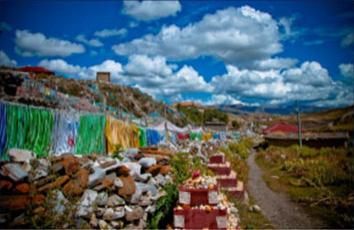
It is a custom to engrave mantras, figures of Buddha and the scriptures on stones in Tibetan areas and the stones are called Mani stones. The spirititual Mani piles, which are initially called Manja-mandala, are put up by all sizes of stones named "Duo Ben" in Tibetan. Some mantras, figures of Buddha and the scriptures are engraved on the top of a cliff, and some are on stone sheets. A large number of piles are put up in the selected special place such as roads with pedestrians or places with geomantic defects. After the consecrations and blessings, Mani stones are able to promote the local peace. And the stones are often piled up to a long wall which is called "Mian Dang" in Tibetan. So they can give all the passing sentient beings blessings and benefits of the Dharma.
◆ The conservation trait of Mani stones
Patrul Rinpoche wrote down the following words for Mani piles, "To build Mani stones can benefit all sentimental beings endlessly. But agger and mud statues are invaded by water easily; Gold and silver statues have the risk of being stolen; Murals and thangkas are also vulnerable; Building scripture halls is difficult to guarantee daily support and management. Although we can write the classic scriptures on books, they also scatter easily. As long as the construction of Mani stones is complished, there is no need to repair roof to prevent the leaks in summer, to sweep the snow to fend off the coldness in winter, to be beware of bird's nests and rat problems, and to have a steward and a lamp lighter. Other people only do some trivial things to get merits like only grab the branches of a tree that can benefit beings. However we do the prime deed to benefit all beings like hold the root of the tree. Even if evils and robbers are all over the mountains and plains, we also need not to concern about the safety of the stones and they will exist in many generations."
◆ Continuous blessing power of Mani stones
If you contribute to the engraving of Padmasambhava Mantra on a stone, you will get not only the merit of engraving Mani stones, but also all merits of walking and praying around the Mani stones. Mani stones can be preserved for a very long time, even for thousands of years. They will not decay. Mani merits will not disappear even stones have rotten. Every participant gets blessings continuously in every realmof Samsara whichever one reborn in.
◆ The benefits of touching, hearing, thinking about Mani stones
All beings will get blessings from Mani stones by the caress of the wind passing it. The ill who enshrine and walk around Mani stones with a saintly heart, will gradually recover from illness. Aspired people who vow to carving more Mani stones will get good karma, health, good luck and increasing fortunes for generations.
◆ Engraving Mani stones for dead relatives in Tibetan traditions
Someone in Guori area sent a message after the death and said, "Although I am in the hell now, I can still send a word because I walked around the Mani piles in the past. You should also rest your hope on the holy land, and you will get more benefits." There is a Tibetan tradition. if a family has seven persons and one of them died, his family will say, "We can get through all difficulties because we are still alive. But the dead is friendless and helpless, so we should do something good for him." Ordinary families will take out one seventh of the family property to do charity, but some families even take out more. Moreover, the gifts and the money given by relatives and friends, is going to be used for carving the Mani stones, printing of scripture flags or for 49-day Buddhist ceremony, etc.
◆ Mani stones and confessions,vows
Ordinary confession and vow Mani stones are mainly engraved with words and supplementary images. The background of confession Mani stones is mainly the situation that people trampled a bug, a frog or a small organism to death at working fields. Although it is not an intentional accident, a life died away after all. So people carve Mani stones with images of frogs and snakes after devout prayings on a very auspicious day. One or several sentences of Chenrezig mantra(Om Mane Padme Hum) are engraved on the facade of the stone with a line of "Atone for killing a snake and salute Buddha" on the back.
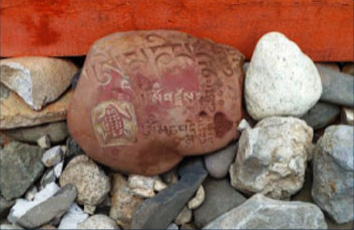
Mani stones of vows are very common in many areas. This kind of Mani stones are generally engraved with puppies, lambs or a piece of paternoster. They are made by the people who are born in the dog or sheep year because the people have done something against the Buddhist doctrine, even some illegal deals, which are not known by others. But they are upset because themselves know, the heaven knows, the earth knows, Buddha knows. So they go to a place far away to ask a craftsman to carve a Mani stone with a personal mark on (such as the Chinese zodiac) to sacrifice and swear to the Buddha, "Never do it again". Even heavy smokers or drinkers do the same thing to give up addictions.
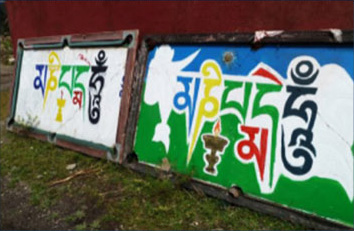
The Mani piles in the above picture were billiard tables. Local Tibetans who belive in karma determined to abandon discursive gambling and entertainment habits after attending the "Padmasambhava Wish-Fulfilling Dharma Assembly" at Manigange town. They engraved the symbols of Buddha and mantras on the billiard tables to express the determination of reforming themselves. It is really remarkable.
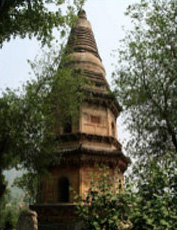
◆Fang Shan Stone Sutras in Han area prevents Dharma from losing
" Sramana Zhiyuan(Jingyuan)was very knowledgeable in You District in Sui dynasty. He swore to make stone sutras in case of the decay of Dharma. Then he resided in Bei Mountain, chiseled rooms in stones and engraved sutras inside on the stone wall. He even took in more slices of stone to carve. So each room which is filled with stone sutras was then locked up with large stone and he also used the iron to consolidate the doors." "He made seven stone rooms filled with stone sutras, and he died in the thirteenth year of Tang Dynasty. His disciples continued the work." Master devoted his whole life to the promotion of Buddhism. He built up the YunJu temple, chiseled stone sutras and buried Buddha's relic for supports. The three great things have made the YunJu temple a famous ancient Chinese Buddhism temple with stone sutras and Buddha's relic all over the world.
People get old from generation to generation. Turbulence and roughness or ordinary and peace shares the same status in one hundred years. But the earth-shaking and moving deeds transcend the restriction of life and last forever. Sometimes a single person is insignificant in human history. Fang Shan Stone Sutras watches the flowing of time over one thousand years in the place where they were hidden quietly.
Prayer of Padmasambhava for Saving All Sufferings
(A terma discovered by the first Chewu Rigzin Chenbo Rinpoche, whose fifth incarnation was the father of the fifth GryaRong Namgr Rinpoche)

